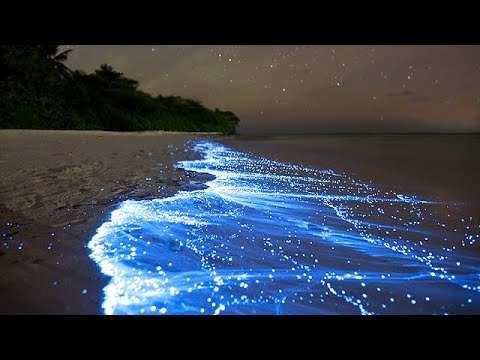Sea of Stars

Beneath the velvety blanket of the night sky lies a spectacle that captivates the imagination and stirs the soul—the Sea of Stars. This mesmerizing phenomenon, often witnessed in remote corners of the world, presents a surreal landscape where the ocean meets the heavens in a dance of bioluminescent wonder. With each gentle wave, the waters illuminate with a celestial glow, painting the night with an otherworldly allure. In this article, we delve into the enigmatic beauty of the Sea of Stars, exploring its origins, ecological significance, and the awe it inspires in those fortunate enough to behold its ethereal splendor.
Origins of the Phenomenon:
The Sea of Stars owes its mystical radiance to the presence of bioluminescent microorganisms, predominantly dinoflagellates, which inhabit certain coastal waters around the world. These microscopic organisms possess the remarkable ability to emit light through a chemical reaction known as bioluminescence. When disturbed—be it by the movement of water or the touch of a passing creature—these organisms emit a brilliant blue-green glow, transforming the surrounding ocean into a shimmering canvas of light.
The exact mechanisms behind this phenomenon are complex yet fascinating. Within the cells of these bioluminescent organisms, a molecule called luciferin reacts with oxygen in the presence of an enzyme called luciferase, resulting in the emission of light. This process, while essential for their survival, also gives rise to the breathtaking displays witnessed in the Sea of Stars.
Ecological Significance:
Beyond its aesthetic appeal, the Sea of Stars plays a vital role in marine ecosystems. Bioluminescent organisms often reside in regions rich in biodiversity, where their presence serves as an indicator of environmental health. These organisms form an integral part of the marine food web, with some species feeding on them directly while others benefit indirectly from their presence.
Moreover, the bioluminescent glow of these organisms serves as a form of defense against predators. By emitting light in response to disturbance, they startle and confuse potential threats, allowing them to evade capture and continue their vital ecological functions. In essence, the Sea of Stars is not merely a spectacle for human observers but a testament to the intricate interplay of life within the ocean depths.
Global Hotspots: While the Sea of Stars phenomenon can occur in various parts of the world, certain regions are renowned for their particularly stunning displays. One such location is Vaadhoo Island in the Maldives, where bioluminescent plankton turn the shoreline into a celestial spectacle after nightfall. Here, visitors are treated to the sight of waves breaking into luminous trails of light, creating an enchanting ambiance that is nothing short of magical.
Another notable hotspot is Mosquito Bay in Vieques, Puerto Rico, often referred to as the brightest bioluminescent bay in the world. The bay’s shallow, sheltered waters provide an ideal habitat for dinoflagellates, resulting in an immersive experience where every movement sets off a cascade of glowing ripples—a sight that leaves spectators in awe of nature’s brilliance.
Preservation Efforts:
Despite their ecological importance and cultural significance, bioluminescent habitats face various threats, ranging from pollution and habitat destruction to climate change-induced alterations in oceanic conditions. As such, conservation efforts are crucial to safeguarding these fragile ecosystems and preserving the Sea of Stars for future generations to enjoy.
Community initiatives, scientific research, and sustainable tourism practices play pivotal roles in mitigating these threats and raising awareness about the importance of marine conservation. By fostering a deeper understanding of the interconnectedness of all life forms within these ecosystems, we can work towards ensuring their long-term viability and protecting the wonder of the Sea of Stars.
Conclusion:
The Sea of Stars stands as a testament to the awe-inspiring beauty and complexity of the natural world. From its humble origins in the microscopic realm to the breathtaking displays witnessed on moonlit shores, this phenomenon invites us to marvel at the wonders of life beneath the waves. As stewards of the planet, it is our responsibility to cherish and protect these fragile ecosystems, ensuring that the ethereal glow of the Sea of Stars continues to illuminate the night sky for generations to come






